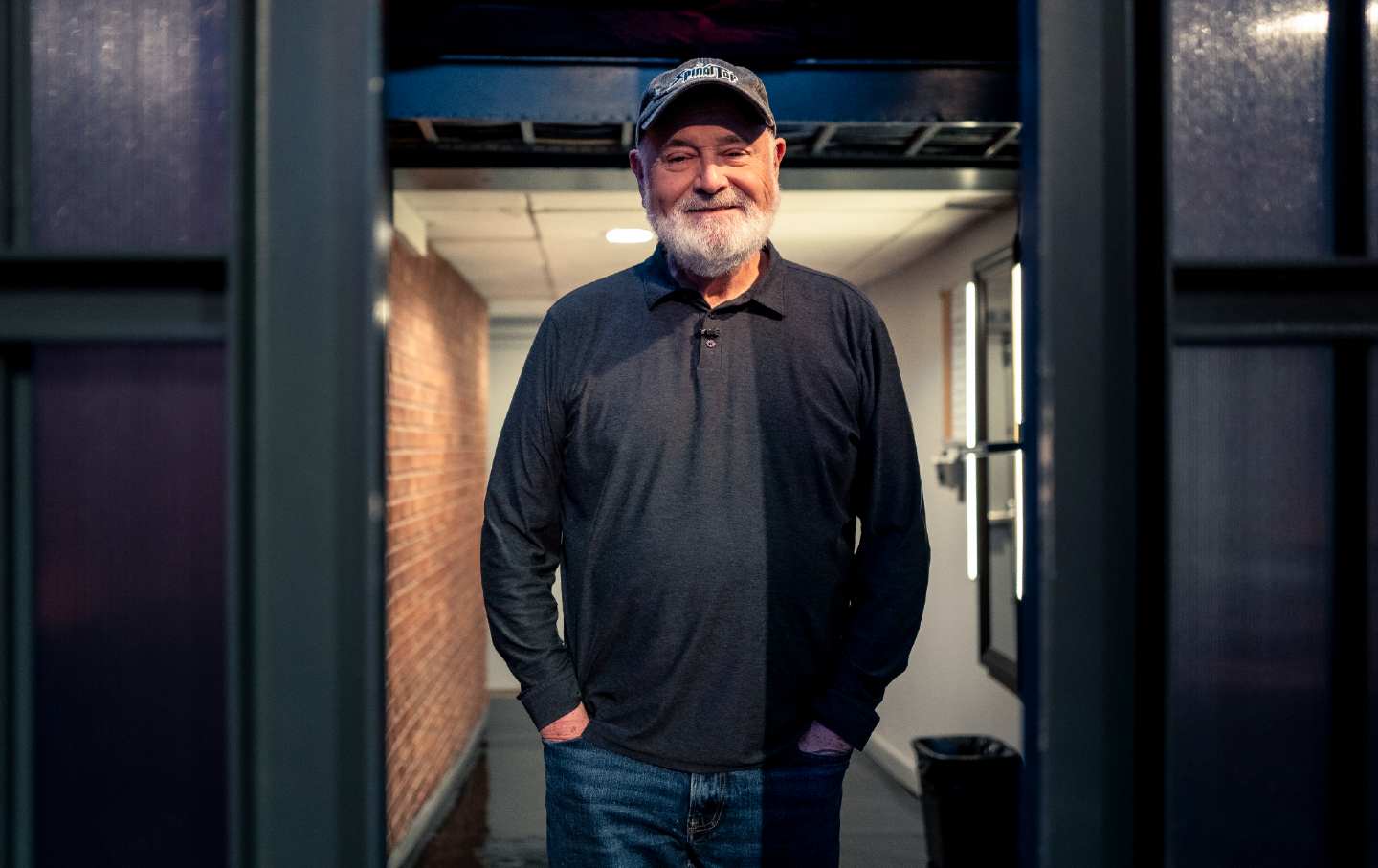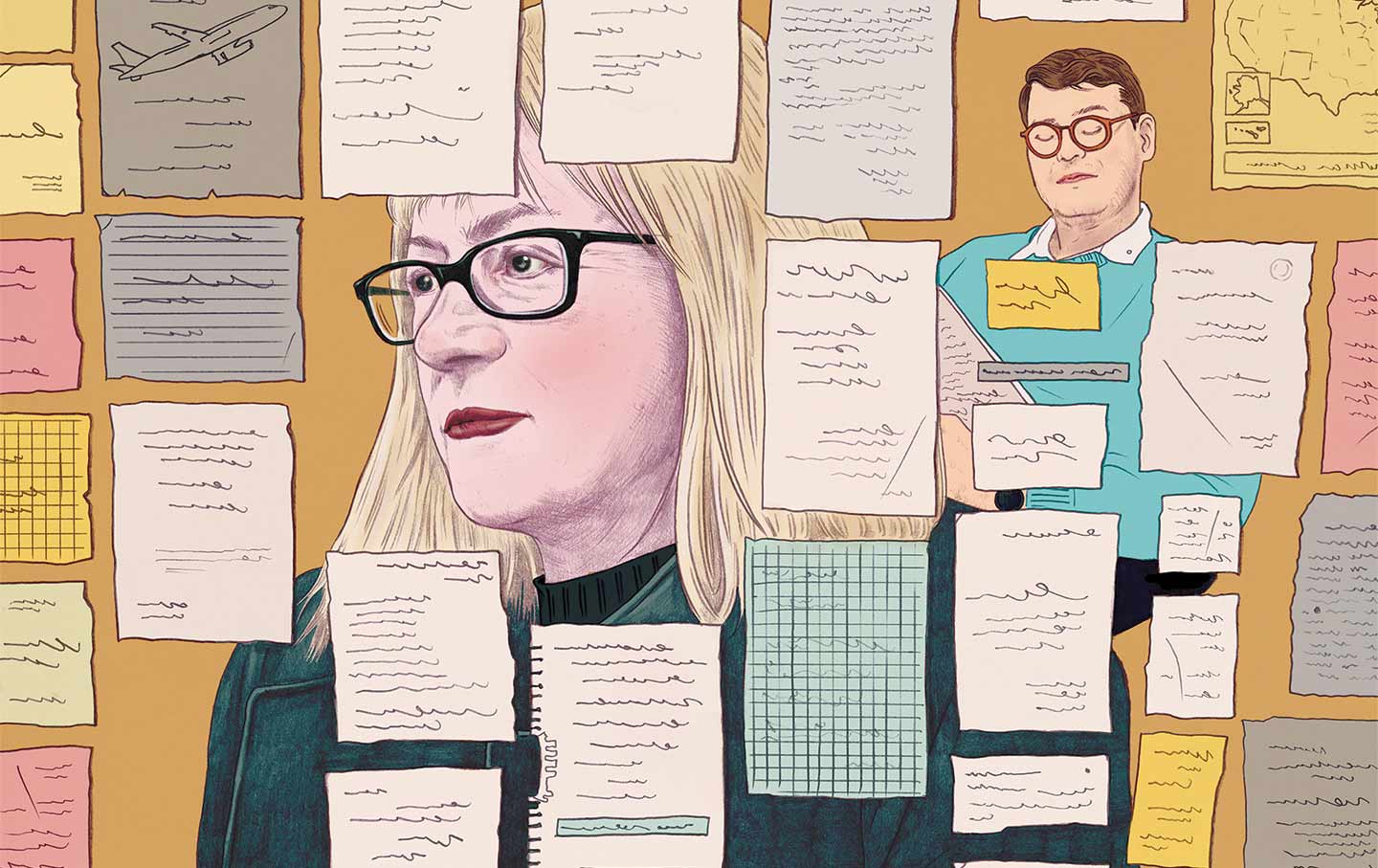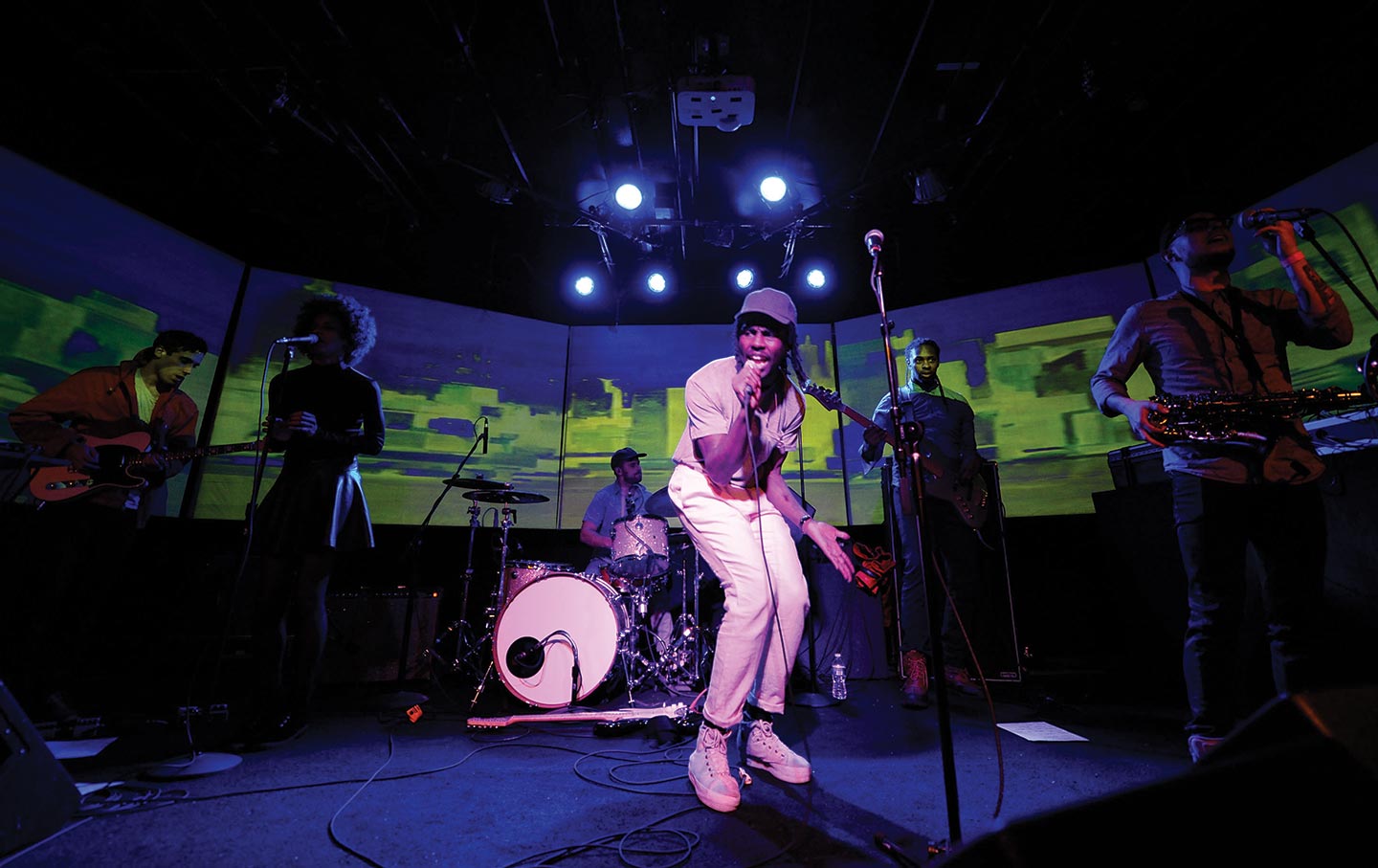Downtown
Keith Haring’s New York.
Keith Haring and the Downtown Art Revolution
A new biography tells the story of not only Haring’s life but also the exhilarating world of New York art in the 1970s and 80s.

We are attracted to the biographies of artists for a variety of reasons. We want to learn about their childhoods and lost loves, their petty and legitimate grievances, and the unfolding of their greatest ambitions. We want to understand how they did it. But when the artists are part of the doomed generation that saw thousands brutally cut down by AIDS at an obscenely young age, we are also drawn to their biographies for another reason: to better comprehend the mystery of the painful obstacles that defined their shortened lives, and how these experiences intersected with their creations.
Books in review
Radiant: The Life and Line of Keith Haring
Buy this bookBrad Gooch’s new biography of one such artist, Radiant: The Life and Line of Keith Haring, does precisely that, telling the story of Haring’s childhood in Pennsylvania, his meteoric rise to riches and global fame, and his final years as an AIDS activist. Gooch’s own history intersects with Haring’s in many ways: His partner, Howard Brookner, died of AIDS after making acclaimed documentaries about William Burroughs and Robert Wilson (he’d even completed a feature film with Madonna shortly before his death), while Gooch has also written an important biography of the poet Frank O’Hara, another person who died tragically young. But his retelling of Haring’s life and times offers him a chance to chronicle something else as well: not just a history of past events, but a story about art and New York City that continues to this day.
Born in 1958 in Reading, Pennsylvania, Haring grew up in a stable, happy, all-American small-town family. He began to draw at an early age as a result of the loving and playful attention he received from his father, Allen. In Haring’s case, artmaking wasn’t so much an escape from loneliness or isolation as it was a way to bond with his father. The pair made many things together, and everything from Haring’s cartooning to his love for Japan originated in this relationship. Even Haring’s later iconic images of barking dogs came from these idyllic early years. Their repeated appearance in his work were not allusions to a bullying father, or a set of neighborhood toughs, or a series of mysterious fears in the middle of the night. Simply, they were neighborhood dogs that little Keith was afraid of, which sat at the foot of the stairs of their housing complex.
Equally happy was Haring’s relationship with his maternal grandmother, who, Gooch tells us, let him watch TV, first black-and-white and then color. His grandmother also subscribed to Life magazine, where he first learned about the rest of the world and, as important, was exposed to images of it. Magazines also introduced Haring to erotic male objects: His grandmother bought him a much-coveted Ken doll, and he purchased pop music publications from which he cut out photos of his crush, Davy Jones of the Monkees.
Yet Haring’s early years were defined by an internal conservativism, and in 1972, at the age of 14, he discovered not radical politics but the power of Jesus: He became born again and subscribed to a series of orange stickers sold by the Rev. Billy Graham, showing a black finger pointing to a cluster of crosses. In a trial run for his future of public artmaking, Haring pasted these Jesus peel-offs all over Reading’s telephone poles and the shop windows on Main Street. His need to make his mark on the landscape of public space began early, long before any specific content or aesthetic had evolved. Those vibrant crosses would soon be joined by the iconic radiant babies and then the images of sexuality that would come to define his later, radical work.
At the age of 15, Haring did begin to break out of the conservative world of his upbringing. After smoking pot on Halloween, he began a period of significant drug consumption, imbibing the 1970s panoply of drugs: black beauties, Quaaludes, and, of course, LSD. Haring’s drug use marked the beginning of a change—his transition from a good boy to a rebel. While he occasionally and publicly went too far, the antisocial aspects of being with the druggy kids in town produced more independence, more creativity, and more reckless adventuring. It was during a high school field trip to New York that, following in the tradition of his earlier Christian public art, Haring wrote on a subway poster with a magic marker. Transgression became possibility.
From that point on, Haring began to experiment with new and bold combinations of artmaking and daily life. At the commercial art school in Pittsburgh that he attended, he incorporated the bounce of the trolley car into his technique and made art based on characters he saw on bus routes. He was always prowling side streets looking for found materials, always trying to bring art closer to daily experience. “I am not interested in art as a way of making a living,” he wrote, “but I am interested in art as a means of living a life.” Interestingly, success came so fast that he never had to test his concept against either an adult life of poverty or the humiliation of marginalization.
In 1978, Haring moved to New York City to attend the School of Visual Arts. Having only tentatively broached his homosexuality before arriving, he found that the city in the late 1970s was the gay man’s perfect welcome to Oz. He got a room for $40 a week at the YMCA on West 23rd Street. The next day, he went to the piers and met a guy who brought him home to his shared apartment on 10th and Bleecker, where, after chatting with the gay landlord, Haring decided to move in. The day after that he started classes, with tuition priced at $2,800 a year. This is how the flexible economy of the 1970s and the special pathway for good-looking gay men colluded to make life so easy and dreams so seemingly obtainable. Though he didn’t always do his homework assignments, he was hard-working and extremely productive on his own terms. That same first week in town, he made a video featuring himself and music from Devo. The description of a young Keith, newly arrived in New York, reminds me of so many gay men of his time. And the photos of him are also associative: He was every bit as influenced by the look and sound of the era as the thousands of other gay men filling the streets of the East and West Village and Chelsea—lean muscles, cut-off sleeves, New Wave. It was his method that stood out more than Haring himself: Filled with energetic ideas, talented and with a huge work ethic, he was simultaneously completely palatable and special—the magic combination.
In a drawing class with Barbara Schwartz, Haring responded to an assignment about developing a theme by drawing penises, an accurate reflection of what he was seeing in his daily sexual landscape. He made penis postcards drawn using red ink, crayons, and wax. His penises were “radiant or winged, weaponized or dressed in blonde wigs,” Gooch tells us.
Haring continued his video work as well, which now grew in scope and technique and included performance painting, collecting materials, and physicalizing the abandon with which he made art. He also put his work up in the hallways at school and in other people’s spaces; this time, instead of Jesus, the message was Keith. Like most newcomers, Haring defined the city by his own experiences: He described the 1970s East Village as “barren” when it was fully alive with the productive human mix, but upon moving there in 1980, he embraced the neighborhood and took on a sense of cultural superiority, stenciling “Clones go home” on the sidewalk. In his $240-a-month shared apartment on First Avenue, he also created a wallpaper of flying penises.
As New Yorkers of that era will recall, a public artist named Taki 183 had covered the city with his magic marker tag in the late 1960s, and this was followed by a carpeting of graffiti on every public surface of the city. There were artists covering train cars with bubble-style spray-can work, and there were gangs tagging buildings to delineate their territory. The graffiti and tags were a way for poor people and artists of color to reclaim New York as their home turf. It was an expressive insistence on their presence, their point of view, and their experience as a set of communities that had been systematically silenced.
Since the East Village had a strong Nuyorican presence, graffiti abounded. And since it had a strong art-scene presence, aspiring artists participated as well. There was someone named “Rene” who repeatedly insisted on walls: “I am the best artist.” There was “SAMO,” a collaboration with Al Diaz that was eventually claimed by Jean-Michel Basquiat. And there was a band called Missing Foundation that covered the neighborhood with an upside-down martini glass and the warning “The party’s over.” Some graffiti artists of color, like Lady Pink and others, also began to migrate into the art world, with their art becoming part of the commodity-objects gallery system.
Haring soon got involved in the graffiti scene as well as the queer scene of Manic Panic hair dye, the B-52’s, and cheap Polish food. A hard-working and perceptive young man who enjoyed imagining, he soon became friends and collaborators with an exciting list of artists and East Village types: not just Basquiat and Kenny Scharf and John Sex, who also died of AIDS, but also lesser-known but iconic women dancers such as Molissa Fenley and Simone Forti, the actress Ann Magnuson, and, of course, Madonna.
How does a student at the School of Visual Arts end up sliding into the lives of such an array of exciting and influential artists? Is it too easy to say that things were different then? There were fewer artists, because the professionalization process of MFA programs with their homogenizing selection apparatus was just kicking off. The city was economically viable, and so edgier, more innovative people had a chance to live there and make work. Not every single thing had been commodified, and marketing and branding were not the foremost interests of younger people. It may be fair to say that given the different social conditions, artists were fewer and more interesting and therefore the field was more open and less controlled. And because there was a collective process of discovery taking place, everything was interdisciplinary, and most people—even the nerdiest writers like myself—ended up on a stage performing something. Improv was a way of life, and collaboration its only means.
Haring’s initial forays into this exciting world of public art were wheat-pasted posters with overtly political themes combining anti-Reagan sentiments with tabloid formats. But soon he was drawing on the empty black advertising panels at the F train station near his new place in Times Square. He used low-dust Crayola Chalk and started with his lifelong referents: barking dogs, radiant babies, and the new addition of UFOs. These drawings victoriously passed the greatest test of their popularity: They usually remained intact, neither written over nor taken down. Subway riders showed respect for them and treated them like artworks. A marketing genius with a natural instinct for advertising, Haring made a thousand tiny lapel pins with radiant babies on them and handed them out as his own version of free publicity. The photographer Tseng Kwong Chi, who worked with Haring at the Mudd Club, started documenting his street art. Within a couple of months, Haring had received two summonses and was handcuffed by the police in the Prince Street subway station for his pains. Over the next five years, he made more than 5,000 chalk drawings in all five boroughs.
Haring’s first solo show in New York was in the Westbeth Painter’s Space gallery in February 1980. From there, his rise was meteoric by most measures, while his five-year romantic partnership with Juan Dubose was grounding. Gooch provides plenty of insight into Haring’s developing career and persona and the changes in the surrounding art world, but at times he is less successful in capturing the foundational cultural explosion of “Downtown,” which is odd because he was part of it. Some of the context he does provide feels by-the-book and lifeless, perhaps because there is a lot of pain there for the survivors of AIDS and gentrification.
Popular
“swipe left below to view more authors”Swipe →Despite Haring’s worldwide fame and postmortem permanence, his greatest accomplishment is how he faced his own suffering and impending death from AIDS and his contribution to the larger AIDS community. Like many, Haring assumed that he was probably infected based on his sexual history, and he had early symptoms like swollen lymph glands even before an HIV test was developed. As his first close friends died, Haring’s fears turned to the inevitable, and in 1988 he discovered two Kaposi’s sarcoma lesions on his body. Yet he continued to work incessantly, and a new content emerged: He made a painting based on the “Silence = Death” poster created by a collective and then donated to ACT UP. This painting accompanied dark works about the greed of American industry. Although Haring and Dubose were no longer a couple, when Juan became sick with AIDS and ended up in St. Luke’s Hospital, Keith visited him there and arranged for access to AZT (then being misprescribed as a stand-alone therapy) and a television set, but Dubose died the next day. In Barcelona, Haring created his first AIDS mural, with a trademark snake’s head and a syringe.
By 1989, Haring had fewer than 20 T-cells. AZT was making him anemic and not helping. He was on the drugs of the moment: DDI, Bactrim, and alfa-interferon. At this point, Haring joined ACT UP and, in an unusual act for celebrities at that time, agreed to come out publicly as a person with AIDS when he signed a direct-mail fundraising letter for the organization. The letter netted $70,000, in addition to the cash donations he made to ACT UP and his gift of a fundraising poster that read “Ignorance = Fear.” He also paid for buses to the Montreal AIDS Conference and for an ACT UP action in Washington, D.C., and can be seen in Jim Hubbard’s documentary on the group, United in Anger: A History of ACT UP. Haring’s openness about being infected and his decision to join the collective fight-back resulted in news of his diagnosis being discussed in a Rolling Stone interview, followed by a notice in “Page Six,” the gossip column of the New York Post.
Radiant’s final chapter, which depicts the end of Haring’s life, is rich, emotional, and compelling, and also features the best writing in the book. Since Haring was a highly energetic and productive person as well as someone with a lot of money and social resources, the record of his final days is a kind of clichéd dream of dying fully: He traveled around the world, took his friends and parents on high-end trips, partied, created artwork for poor communities and private wealth. He relied on and thanked friends and supporters, and he made art for as long as he could.
Gooch’s book helps to fill in the crater that is the untold story of the queer art movement after Andy Warhol and before Rent—one of the largest gaps in LGBTQ art-political history and in the story of the city itself. While a number of biographies are appearing or in the works, a much larger and more sweeping public history needs to be amassed of the thousands of men and women who made art in social and geographic proximity from 1979 to 1995: who they were to each other and what they discovered. Hidden in that collectivity of mostly unrecognized and underrecognized people is the foundation of art, advertising, questions of truth versus commerce, and sexual-political thinking upon which our contemporary moments of crisis and revelation are created. The mass-death experience of the risk-taking young had consequences that remain to be unearthed, within our archives and within ourselves.
Disobey authoritarians, support The Nation
Over the past year you’ve read Nation writers like Elie Mystal, Kaveh Akbar, John Nichols, Joan Walsh, Bryce Covert, Dave Zirin, Jeet Heer, Michael T. Klare, Katha Pollitt, Amy Littlefield, Gregg Gonsalves, and Sasha Abramsky take on the Trump family’s corruption, set the record straight about Robert F. Kennedy Jr.’s catastrophic Make America Healthy Again movement, survey the fallout and human cost of the DOGE wrecking ball, anticipate the Supreme Court’s dangerous antidemocratic rulings, and amplify successful tactics of resistance on the streets and in Congress.
We publish these stories because when members of our communities are being abducted, household debt is climbing, and AI data centers are causing water and electricity shortages, we have a duty as journalists to do all we can to inform the public.
In 2026, our aim is to do more than ever before—but we need your support to make that happen.
Through December 31, a generous donor will match all donations up to $75,000. That means that your contribution will be doubled, dollar for dollar. If we hit the full match, we’ll be starting 2026 with $150,000 to invest in the stories that impact real people’s lives—the kinds of stories that billionaire-owned, corporate-backed outlets aren’t covering.
With your support, our team will publish major stories that the president and his allies won’t want you to read. We’ll cover the emerging military-tech industrial complex and matters of war, peace, and surveillance, as well as the affordability crisis, hunger, housing, healthcare, the environment, attacks on reproductive rights, and much more. At the same time, we’ll imagine alternatives to Trumpian rule and uplift efforts to create a better world, here and now.
While your gift has twice the impact, I’m asking you to support The Nation with a donation today. You’ll empower the journalists, editors, and fact-checkers best equipped to hold this authoritarian administration to account.
I hope you won’t miss this moment—donate to The Nation today.
Onward,
Katrina vanden Heuvel
Editor and publisher, The Nation
More from The Nation

Rob Reiner’s Legacy Can't Be Sullied by Trump’s Shameful Attacks Rob Reiner’s Legacy Can't Be Sullied by Trump’s Shameful Attacks
The late actor and director leaves behind a roster of classic films—and a much safer and juster California.

Helen DeWitt and Ilya Gridneff’s Sweeping Anti-War Novel Helen DeWitt and Ilya Gridneff’s Sweeping Anti-War Novel
Your Name Here dramatizes the tensions and possibilities of political art.
Solution to the “Big Event” Crossword Solution to the “Big Event” Crossword
If questions remain after reading this, please write to sandy @ thenation.com.

Blood Orange’s Sonic Experiments Blood Orange’s Sonic Experiments
Dev Hynes moves between grief and joy in Essex Honey, his most personal album yet.




